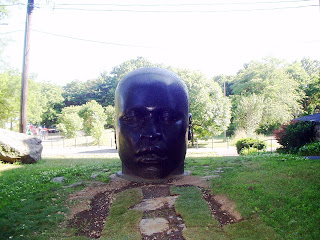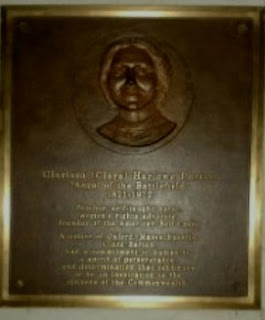Haitian Artists Embrace Creative Expression in Museum Exhibit

Less than one month ago, on Tuesday, January 12, 2010, a devastating 7.0 magnitude earthquake hit the Caribbean island nation of Haiti. The earthquake has brought terrible destruction to the country of 9 million people. Despite the lingering effects of the earthquake the Haitian people continue to endure through extremely challenging circumstances. In reading about how the people of Haiti have survived this natural disaster, I was reminded of another aspect of Haiti that I learned about last year.
In June 2009, I visited the Museum of the National Center of Afro-American Artists (NCAAA). Located in Boston, Massachusetts, the Museum primarily hosts exhibits created by African American artists. The NCAAA is the largest independent black cultural arts institution in New England. In 1968, the Museum was founded by Dr. Elma Lewis. Outside of the Museum there is a sculpture that was crafted by John Wilson. Built in 1987, Eternal Presence is an example of the NCAAA’s mission for promoting creative expression by African American artists. Eternal Presence is based on aspects of ancient Mexican and Buddhists traditions.
When I visited the Museum one of the exhibits on display was Escape: Works by Fritz Ducheine. This display was one of four separate exhibits that I looked at during my visit to the Museum. Ducheine, who was born in Plaisance, Haiti, is a self-taught painter who has been an artist since he was a teenager.
The Escape exhibit displayed paintings that portray Ducheine’s feelings on how to address the prevalence of violence in society and the desire for hope to create a safer world. The exhibit included a total of seven works of art including: Ground Zero, Judgment Day, Legba’s manifestation, Sacrifice, and The horrible days of Kosovo. Hope in a Wounded World (2002, mixed media) is one of the seven paintings in the Escape exhibit. Ducheine’s message in this painting shows his belief that religious faith is a key part of surviving after tragic events. “Since my childhood, I had an intense feeling for colors,” the artist says. Ducheine is also a member of the Haitian National Arts Assembly of Massachusetts.
Haiti: Paintings by Marilene Phipps was a second exhibit on display at the Museum. Phipps, who is a poet and visual artist, was born in Haiti. In Teramen, (oil on linen, 2000) Phipps writes about the painting that she “wanted to show what dignity, elegance and inner strength can be maintained even in the worst conditions for life, such as squalor and poverty.” In this painting, a woman wearing a pink dress is shown with a confident look on her face and her left arm on her hip. On her website, www.marilenephipps.com, the artist writes: “My work as a painter has drawn on the powerful early sensations and visual excitement of childhood in Haiti, spent at a time when people seemed magically connected to their surroundings and to an invisible realm nevertheless experienced as palpable, tangible, and powerful."
The Ubuntu Quilt and Story Circle were the third and fourth exhibits on display when I visited the NCAAA last summer. Both of these artistic displays were created by a group of young women who are in the juvenile justice system. Story Quilt is a sculpture presentation with the moldings of feet in clay arranged in a circle. The word Ubuntu is derived from the Bantu language. The word describes the philosophy of the interdependence of humanity, “a person is a person through other persons.” The Ubuntu Quilt is an embroidered quilt that highlights ancient hair braiding techniques and masks. A recorded tape featuring conversations with the young artists was played in the room where the Quilt and moldings were displayed.
I enjoyed my visit to the NCAAA. I plan on visiting there again, as well as other museums. For anyone interested in learning about African American and African culture it is a great place!


Comments
Post a Comment